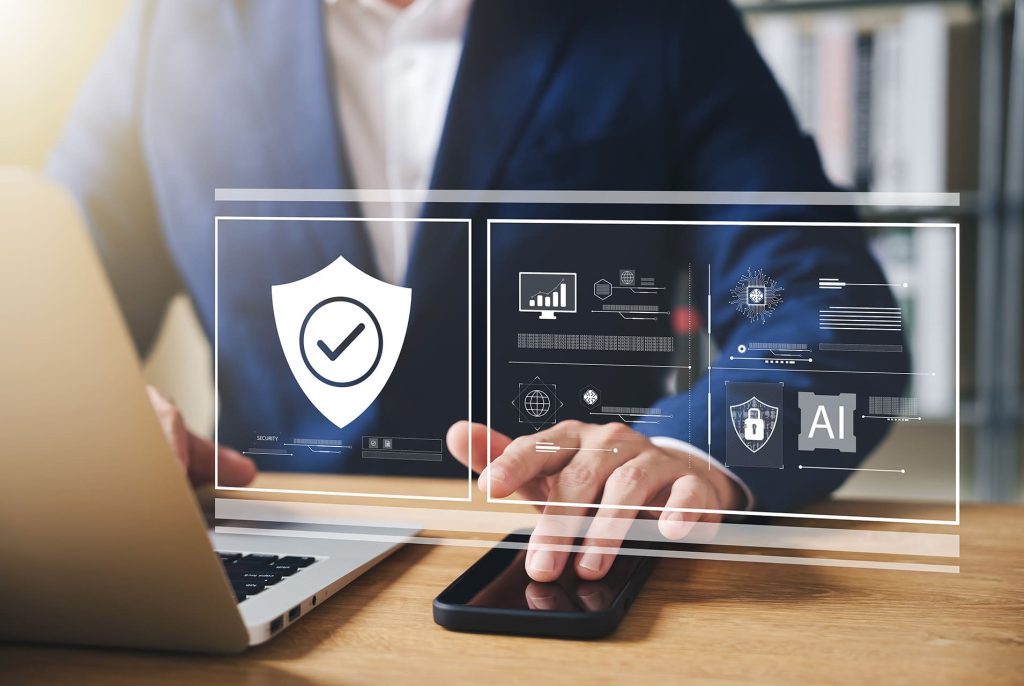
As technology continues to advance at an exponential rate, the need for improved cybersecurity measures becomes increasingly apparent. Cybersecurity has become a critical aspect of businesses, governments and individuals alike, as cyber threats continue to evolve in complexity and scale. The world of cybersecurity is constantly changing, and it is important for businesses to stay up to date with the latest trends and predictions in order to effectively protect against cyberattacks. In this article, we will explore the future of cybersecurity and its potential impact on industries, locations, and strategies, looking as far ahead as 2030.
What Is The Future Of Cybersecurity?
The future of cybersecurity is a hot topic among businesses across all industries. With the rise of new technologies such as cloud computing, Artificial Intelligence (AI) and machine learning, the landscape of cybersecurity is expected to undergo significant changes in the coming years. The traditional reactive approach to attacks and incidents is no longer enough. Instead, businesses must adopt proactive strategies to stay ahead of cyber threats.
What Are The Areas Affecting The Future Of Cybersecurity?
Over the past few years, we have noticed trends in cyberattacks, and in the ways that businesses are protecting against them. Some examples of areas that impact cybersecurity include:
• Cloud Computing
Cloud computing has revolutionised the way businesses store, access and manage data. However, it has also opened up a new range of security challenges. As more and more businesses move their operations to the cloud, cybersecurity will need to adapt and evolve accordingly. This may include implementing stronger authentication methods, monitoring for insider threats and ensuring data is encrypted both at rest and in transit.
• The Role Of AI and Machine Learning
AI and machine learning are becoming increasingly integrated into cybersecurity strategies. These technologies can help to automatically detect and respond to cyber threats in real-time, which is crucial for keeping up with the speed and complexity of attacks. However, there is also concern that hackers may harness AI for malicious purposes, creating a new challenge for cybersecurity teams.
• The Internet Of Things
The Internet of Things (IoT) is poised to greatly impact the cyber security in future. More and more devices are connected to the internet, collecting and sharing data. This includes everything from smart home devices to industrial machinery. As the number of these devices increases exponentially, so does the potential for security vulnerabilities. Every connected device is a potential access point for cybercriminals. The future of cybersecurity will involve finding ways to secure these devices and the vast amounts of data they generate and share.
Trends That Will Impact The Future Of Cybersecurity
As cybercriminals continue to evolve and adapt their methods, it’s essential for businesses to stay on top of emerging trends and threats. Some of the notable trends that will impact the future of cybersecurity include:
• Cybercrime As A Service
Cybercrime is increasingly becoming a lucrative business for hackers, and the rise of Cybercrime as a Service (CaaS) has made it easier than ever for anyone to get involved. This means that businesses will need to be vigilant not only against skilled hackers but also against less experienced individuals who still have the potential cause significant damage.
• Malware Automation
Malware is evolving to become more sophisticated and automated, making it harder for traditional cybersecurity tools to keep up. Cyberattackers are taking advantage of AI to launch automated attacks which require little effort from their side, but pose significant threat to businesses, since automation makes it easier than ever for attackers to launch advanced and persistent attacks that companies struggle to protect against.
• Polymorphic Malware
Polymorphic malware is a type of malware that constantly changes its code to avoid detection. This makes it extremely difficult for traditional antivirus software to detect and block, creating a significant challenge for cybersecurity teams, who need to find new ways of recognising attacks and securing their data and their operations against them.
• Third-Party Risks
As businesses are diversifying and embracing new technologies, often taking a multi-cloud or multi-vendor approach, so the risks to their operations increases. Each third-party partner that they allow to access their data poses a security risk, offering a potential entry point or vulnerability for attackers to exploit. While using multiple cloud providers and multiple vendors can add significant value for businesses in allowing them to work with experts that meet their unique needs, companies will also need to carefully vet their third-party relationships and implement robust security measures to protect against potential threats.
• The Human Element
Despite the advancements in technology, humans will continue to play a crucial role in cybersecurity. While automation and AI can help detect threats and protect against them, it is ultimately up to the humans within your business to follow security protocols and policies, making them one of the biggest risks when it comes to cyberattacks. As businesses embrace remote and hybrid work and rely more on digital tools, educating employees on cybersecurity best practices and cyber hygiene will be essential for maintaining a strong defence against cyber threats.
Want to learn more about steps that you can take as a business to enhance cyber hygiene? Download our Business Cyber Hygiene Checklist now.
• Increasing Security Threats
The future of cybersecurity is not just about anticipating new technologies and vulnerabilities, but also about understanding how attackers are evolving their tactics. With the rise of CaaS, anyone with minimal technical skills can launch an attack, posing a significant threat to businesses of all sizes. The automation of malware attacks and the creation of polymorphic malware, which can change its form to avoid detection, are also making it more challenging for traditional security measures to keep up.
• Crypto And NFT Scams
As cryptocurrencies and Non-Fungible Tokens (NFTs) gain popularity, so do cybercriminals’ attempts to exploit them. From fake cryptocurrency exchanges and wallets to scams involving fraudulent NFT sales, these emerging digital assets present new opportunities for cyber attackers. As more industries adopt cryptocurrencies and blockchain technology, it will be crucial for businesses to understand the risks involved and implement appropriate security measures.
• Adopting Zero-Trust Principles
The traditional trust model of cybersecurity, where users are assumed to be trusted unless proven otherwise, is no longer good enough in today’s landscape. With the increase in remote work and cloud computing, businesses must adopt a Zero Trust approach, where no user or device is automatically trusted. Instead, identity verification and strict access controls should be required for every interaction with data and apps.
• Improving Response Capabilities
As cyber threats become more sophisticated and frequent, businesses need to have robust response capabilities in place to quickly detect and respond to attacks. This involves investing in advanced threat detection tools like Defender for Microsoft and having well-defined incident response plans and disaster recovery plans in place. Regular security assessments and simulations can also help identify vulnerabilities and improve response readiness.
The Future Of Cybersecurity Based On Industries
The future of cybersecurity will also be heavily influenced by the specific industries and sectors that rely on digital technologies. Here are some potential developments in key industries:
• Banking
Banks are constantly under attack from cybercriminals seeking to exploit vulnerabilities in their systems and networks. In the future, banks will need to stay ahead of new threats by investing in advanced security measures such as biometric authentication, real-time fraud detection, and AI-powered threat intelligence.
• Manufacturing
With the rise of Industry 4.0 and smart factories, manufacturers will need to prioritise cybersecurity to protect their intellectual property, production processes, and supply chain operations. This may involve implementing secure communication protocols for devices that connect to the internet, leveraging AI for anomaly detection, and incorporating security into the design of new products.
• Financial Services
The financial services industry encompasses a wide range of businesses, including insurance companies, investment firms, and credit card providers. As these institutions become more digitised, they will need to invest in technologies like blockchain for secure transactions, as well as strengthen their cybersecurity posture through continuous monitoring and threat intelligence sharing. It will also be critical for financial services providers to train not only their own teams in the threats that face their business, but to train their customers as well – helping them to secure their investments, recognise potential attacks as soon as possible, and have a thorough understanding of what to do when an attack takes place.
• Online Retailing
E-commerce has transformed the retail industry, allowing consumers to shop from the comfort of their own homes. However, this also means that retailers are now vulnerable to cyberattacks such as data breaches and payment fraud. In the future, online retailers may turn to technologies like biometrics and behavioural analytics to enhance security while maintaining a positive user experience.
The Future Of Cybersecurity Based On Location
While the future of cybersecurity is universal, each county in the world is facing their own unique challenges and trends when it comes to cyberattacks and response mechanisms. Let’s take a look at just a few of them:
• South Africa
As one of the largest and most developed countries in Africa, South Africa has a growing economy that relies heavily on technology. However, with this dependence comes an increased risk of cyberattacks.
One of the most significant threats facing South Africans is phishing attacks, where hackers impersonate legitimate businesses to trick individuals into revealing sensitive information. South Africa has been marked as one of the top countries globally for phishing attacks due to its rapidly digitising economy and the lack of cybersecurity awareness among the population.
Another critical risk is the cyberattacks against critical infrastructure such as power grids and water supply networks. These systems are increasingly becoming automated and connected to the internet, making them vulnerable to cyber-attacks that can cause widespread disruption and even potential national security issues.
Finally, the rise of mobile banking and digital payments in South Africa has been met with an increase in financial fraud and data breaches. Cybercriminals are exploiting the vulnerabilities in these systems, leading to significant financial losses for individuals and businesses alike.
The future of cybersecurity in South Africa sees these risks increasing exponentially, and businesses that operate in South Africa are going to need to implement robust cybersecurity strategies and infrastructure. We see companies around the country investing in advanced technologies like AI, machine learning, and blockchain to protect critical infrastructure and sensitive data over the coming years. But businesses also shouldn’t need to act alone. There is a need for collaboration between government agencies and private organisations to combat cybercrime effectively.
• The UK
The UK is known as one of the world’s leading nations when it comes to cybersecurity capabilities. However, with new threats emerging every day, the country must stay ahead of the curve by continuously updating its strategies and investing in innovative technologies. This may involve partnerships between industry experts, government agencies, and academic institutions to share knowledge and resources.
With the increased use of IoT devices, businesses in industries such as manufacturing and healthcare, the UK will face new challenges in securing these systems. There is also a growing concern about the impact of cyberattacks on critical infrastructure like energy grids and transportation networks. As technology becomes more integrated into daily life, the potential impact of cyberattacks also increases.
To address these challenges, the UK government has set up various programs and initiatives to enhance cybersecurity measures across all sectors. This includes developing a National Cyber Security Strategy, investing in research and development for new technologies, and providing training opportunities for businesses and individuals alike. The future of cybersecurity in the UK relies heavily on collaboration between different stakeholders to stay ahead of evolving threats.
• The USA
The USA is often seen as a leader in technological innovation, but it also faces significant cybersecurity challenges. With the rise of cybercrime and state-sponsored attacks, the country must take proactive measures to protect its citizens and businesses from potential threats. This involves not only implementing robust cybersecurity protocols but also investing in talent and resources to stay ahead of ever-evolving tactics used by hackers.
One particular area that the US must focus on is securing critical infrastructure such as power grids, transportation systems, and communication networks. These systems are essential for the functioning of society, making them prime targets for malicious actors looking to cause chaos or disruption.
To address these concerns, the US government has implemented various initiatives aimed at promoting information sharing between public and private sectors, supporting research and development of new cybersecurity technologies, and creating a skilled workforce to combat cyber threats. The future of cybersecurity in the US depends on continued investment and collaboration between all stakeholders.
The Future Of Cybersecurity in 2030
The year 2030 may seem far into the future, but with the rapid rate of technological advancement, it is essential to think about how cyber threats and cybersecurity will evolve by then. As our world becomes increasingly connected through the IoT and AI, the potential for cyberattacks also increases. So what is the future of cybersecurity 7 years from now? We expect that by 2030, the world will be embracing:
• New Strategies
By 2030, new strategies will have been developed to protect against a wide range of emerging threats. These could involve innovative ways of using advanced AI systems to detect and mitigate attacks, implementing stricter regulations for data protection, and developing hardware and software that is innately more secure.
• Growing Complexity
As technology becomes more complex, so do the methods used by cybercriminals. In 2030, we can expect to see a growing complexity in cyberattacks, making it even more challenging to defend against them. But we also see cybersecurity techniques to address these attacks becoming more sophisticated as well. With each new form of cyberattack, technology is advancing to protect against it, so we expect to find complex and sophisticated systems of protection in place for businesses by 2030.
• Finding New Ways To Maintain An Edge
Staying ahead of the curve in cybersecurity is not just about advanced technologies and technical expertise. It also requires a strong culture of security within businesses, and seeing individuals embracing their role in protecting themselves and the companies that they work for. Everyone must be aware of potential threats and take responsibility for protecting themselves and their data.
• Embracing Managed Technology Through IT Professionals
In the face of escalating cybersecurity threats, the importance of embracing managed technology cannot be overstated. By 2030, businesses across industries and locations will likely be leveraging the expertise of IT professionals to manage their cyber defences, opting for managed IT services to ensure round-the-clock security. This approach combines state-of-the-art technology with the knowledge and skill of experienced professionals to anticipate, prevent, and respond to cyber threats. It also allows businesses to stay updated with the latest cybersecurity practices and regulations, contributing to a proactive rather than reactive approach to cybersecurity. This shift towards managed technology signifies a deepening understanding of the critical role that IT professionals and technology partners play in safeguarding the digital future.
Where Does Solid Systems Fit Into The Future Of Cybersecurity?
The future of cybersecurity is constantly evolving and is influenced by various factors such as industry, location, and emerging technologies. To stay ahead of cyber threats, it is crucial for governments, businesses, and individuals to stay informed about the latest developments in cybersecurity.
At Solid Systems, we understand the importance of staying up-to-date with emerging threats and technologies, which is why we not only provide cutting-edge solutions for our clients, but work with them to understand their unique business needs. Part of our Solid Systems Review involves evaluating business systems and infrastructure to provide you with a greater understanding of potential risks and vulnerabilities, and develop strategic technology roadmaps to help you address them.
Want to learn more about our Solid Systems Review and the value it can add to your business and your cybersecurity? Visit our webpage for more details.
Frequently Asked Questions
Cybersecurity, in a decade from now, will likely be more complex due to the evolution of technology and emerging cyber threats. It will be highly reliant on artificial intelligence and machine learning for threat detection and response. The development and implementation of quantum encryption methods will revolutionise data security. There will also be a heightened focus on individual digital rights and privacy, ushering in stringent cybersecurity legislation. Lastly, cybersecurity roles will become increasingly specialised, requiring continuous learning and upskilling among professionals.
Absolutely, cybersecurity will be indispensable in the future. As technology continues to evolve, so do cyber threats. As a result, businesses and individuals will need robust cybersecurity measures to protect sensitive data. Cybersecurity will also be crucial for the safe operation of emerging technologies like autonomous vehicles and IoT devices.
Cybersecurity is not just a temporary necessity; it’s a long-term requirement. As long as we embrace digitalisation and depend on technology, the demand for cybersecurity will persist. Its significance will only grow with the rise of new technologies and evolving cyber threats. In essence, we do not see a time in the future when cybersecurity won’t be in demand.
Popular Searches
- Data Migration
- Network Security Threats
- Preventing Cyber Attacks
- Azure Backup and Recovery
- Cloud Migration Checklist
- Software as a Service
- What is Cyber Threat Protection
- Types Of Data Integrity
- Importance of Cloud Security
- IT Infrastructure Management
- types of cyber security threats
- Ways To Protect Business Against IoT Cyber Attacks
- Leveraging Artificial Intelligence





